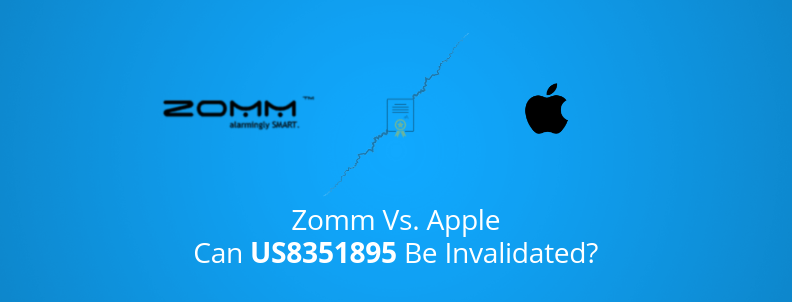Breach of contract, unfair competition, and willful patent infringement – The very terms predominant in the complaint filed by wireless manufacturer Zomm against the Cupertino-based tech giant.
Early in April this year, Zomm filed a patent infringement case against Apple with the Southern District Court of New York. Unlike most other suits, this wasn’t simply an act of willful infringement but had an interesting back story.
Stay with me while I try to narrate these events based on the complaint filed by Zomm.
It was early 2009. Laurie Penix, the president and co-founder of Zomm, had been reading an article on Bluetooth technology. While she was at it, she received a call from her friend who enquired whether Ms. Penix had an extra mobile phone as her husband had lost his phone. Now, call this the combination of circumstances, if you’d like, but at this very moment, Ms. Penix had an idea.
She wanted to develop a product that could prevent users from misplacing their mobile phones while also serving as a security device. This product – Wireless Leash – was launched in January 2010 and won the Best of Innovation award at CES the very same month.
The product received wide acclaim and resultantly, Apple reached out to Zomm to explore the possibility of selling the product through Apple’s brick-and-mortar retail stores and online channels. The original Wireless Leash worked with Apple’s iPhones. Nonetheless, Apple requested that Zomm create a version of the Wireless Leash designed specifically for Apple’s iOS operating systems installed on Apple devices. Zomm reallocated funds, and once it met Apple’s request, Zomm and Apple entered into a mutual confidentiality agreement on July 29, 2010.
With the confidentiality agreement in place, Zomm executives and engineers made several trips to Apple’s headquarters, during which they shared details of what they were planning to develop for the iOS version of the Wireless Leash. The resultant product was the Wireless Leash Plus, released nationwide in November 2011 and was limited to sales within all Apple retail channels.
The features of Wireless Leash Plus included a panic button that allowed users to sound an alarm with a button, which was meant to deter potential attackers and notify others of distress. More importantly, if a user held the button for approximately three seconds longer, the Wireless Leash Plus would dial local emergency assistance anywhere in the world where the user was located without the user having to touch his or her phone.
Now, restricting the sales to Apple stores and the terms of the distribution deal did not leave many profits for Zomm. The deal wasn’t lucrative for Zomm, and they had to find another direction. At CES of 2012, Zomm showcased a new product – Lifestyle Connect- geared towards the Emergency dialing mobile safety product market. The app was received well and won three innovation awards that year.
Now, before I narrate what went wrong with the deal and how it led to an infringement lawsuit, let’s rewind. In 2009, when Ms. Penix had the idea for the wireless leash, she and other inventors filed a patent application covering the same and submitted it to PTO in September of 2009. This patent application was granted as US8351895 titled Wireless security device and method to place emergency calls in August of 2013.
We have come forward a bit too much, so let’s get back to 2012. Ten months after the CES show and Wireless Leash Plus being named an Apple store staff favorite, Apple abruptly terminated its agreement to sell Wireless Leash Plus in its Apple stores and completely removed it from its online store a short while after.
According to Zomm’s complaint, Apple was embarking on a plan to steal Zomm’s patented technology to use in its own products. Between December 2011 and November 2016, several Apple employees ordered numerous units of Wireless Leash Plus directly from Zomm for Apple. Zomm was subsequently informed by another Apple employee that these purchases were being made for R&D.
Ms. Penix tried to reach out to multiple personnel at Apple, including CEO Tim Cook – trying to make him aware of Zomm’s patent and all the orders in the past – but did not receive any response or comment from them.
On September 9, 2014, Apple announced its first iteration of the Apple Watch (the “Apple Watch Series 1”). The product included Bluetooth connectivity to an iPhone and the ability to talk into the device – Two key features of the Wireless Leash Plus. Integrating these features into a watch and other wearable technology was an idea presented by Zomm in one of its early meetings with Apple under the Confidentiality Agreement. Ms. Penix tried to reach out to the tech giant’s CEO again to discuss the possibility of both companies working together again but didn’t receive any reply.
This continued for a while until June 2016, when Apple held a public developer conference where it unveiled additional functionality that it planned to include in watchOS 3, a new operating system for use with the Apple Watch. Among the new features in watchOS 3 was “SOS,” an emergency function that calls an emergency number if a user presses and holds the Apple Watch’s side button for a few seconds.
This feature was clearly covered in Zomm’s patent, constituting willful patent infringement. It also breached the confidentiality agreement, as the feature was present in Wireless leash Plus.
Finally, in April 2018, Zomm sued Apple, alleging willful patent infringement, breach of the confidentiality agreement, and unfair competition. This case was transferred to the Northern District Court of California in August 2018, and the case is (was) in a trial.
Can US8351895 be invalidated?
While reading the complaint, we wondered whether the patent was strong enough to withstand the invalidation tests.
To find the answer, we conducted a preliminary analysis on our end, and what we found was the least surprising.
Can US’895 be invalidated?
Download the PDF to find out.
Zomm LLC preliminary analysis for patent US’895:










